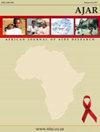多个月抗逆转录病毒药物分配对尼日利亚亚巴68家尼日利亚陆军参考医院艾滋病毒门诊就诊人数的影响。
IF 1.1
4区 医学
Q4 PUBLIC, ENVIRONMENTAL & OCCUPATIONAL HEALTH
引用次数: 0
摘要
背景:数月分配(MMD)抗逆转录病毒治疗已被证明对艾滋病毒患者和卫生服务提供系统有益,包括减少医院就诊频率和改善留用。我们评估了6个月分配(MMD6)在政策改变前后一年对单个军事设施患者就诊率的影响。方法:这是一项描述性、回顾性、横断面研究,探讨MMD6与诊所就诊人数之间的关系。我们回顾了接受抗逆转录病毒治疗的患者的门诊就诊记录,并记录了每月的门诊就诊人数、目前接受抗逆转录病毒治疗的患者人数和抗逆转录病毒治疗的剂量趋势。结果:mmd6前组纳入4150例,mmd6后组纳入4190例。门诊就诊人数为30 407人次(mmd6术前16 111人次,mmd6后14 296人次)。每月平均增加326.58±861.81 (95% CI = -874.15±220.98)个药物;T (11) = -1.31, p = 0.22;月平均就诊次数由mmd6前的1342.8±220.10次下降至mmd6后的1191.33±309.10次,t(11) = 1.601, p = 0.14,但无统计学意义。结论:6个月配药可作为减少HIV门诊数量和提高抗逆转录病毒药物可及性的重要手段。特别重要的是,在军事设施中,服务人员可能被部署或与其家属一起被转移到其他基地。本文章由计算机程序翻译,如有差异,请以英文原文为准。
Effect of multi-month antiretroviral dispensing on HIV clinic attendance at 68 Nigerian Army Reference Hospital, Yaba, Nigeria.
Background: Multi-month dispensing (MMD) of antiretroviral therapy has demonstrated benefits for HIV patients and health service delivery systems, including reduced frequency of hospital visits and improved retention. We evaluated the effect of 6-monthly dispensing (MMD6) on patient clinic attendance at a single military facility in the one-year pre- and post-policy change. Methods: This was a descriptive, retrospective, cross-sectional study, exploring the relationship between MMD6 and clinic attendance numbers. We reviewed aggregate clinic attendance records for clients on ART and documented monthly trends in clinic attendance numbers, number of clients current on ART, and amount of ART dispensed. Results: In the pre-MMD6 group, 4 150 patients were included, and 4 190 in the post-MMD6 group. Clinic attendance was 30 407 visits (16 111 pre-MMD6 and 14 296 post-MMD6). An overall mean increase of 326.58 ± 861.81 (95% CI = −874.15 ± 220.98) drugs were dispensed per month; t(11) = −1.31, p = 0.22; mean monthly clinic attendance declined from 1342.8 ± 220.10 visits pre-MMD6 to 1191.33 ± 309.10 post-MMD6 with t(11) = 1.601, p = 0.14, but was not statistically significant. Conclusion: Six-monthly dispensing can be an important tool to reduce HIV clinic volumes and improve antiretroviral access. It is particularly important for care continuity in military facilities where service members may be deployed or transferred to other bases along with their dependents.
求助全文
通过发布文献求助,成功后即可免费获取论文全文。
去求助
来源期刊

Ajar-African Journal of Aids Research
医学-公共卫生、环境卫生与职业卫生
CiteScore
1.80
自引率
8.30%
发文量
38
审稿时长
>12 weeks
期刊介绍:
African Journal of AIDS Research (AJAR) is a peer-reviewed research journal publishing papers that make an original contribution to the understanding of social dimensions of HIV/AIDS in African contexts. AJAR includes articles from, amongst others, the disciplines of sociology, demography, epidemiology, social geography, economics, psychology, anthropology, philosophy, health communication, media, cultural studies, public health, education, nursing science and social work. Papers relating to impact, care, prevention and social planning, as well as articles covering social theory and the history and politics of HIV/AIDS, will be considered for publication.
 求助内容:
求助内容: 应助结果提醒方式:
应助结果提醒方式:


